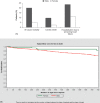Gender-related safety and efficacy of cardiac resynchronization therapy
- PMID: 24105909
- PMCID: PMC6649589
- DOI: 10.1002/clc.22203
Gender-related safety and efficacy of cardiac resynchronization therapy
Abstract
Background: Cardiac resynchronization therapy (CRT) is an established therapy for patients with chronic heart failure (CHF) and a broad QRS complex. Gender-related safety and efficacy data are necessary for informed patient decision-making for female patients with CHF. The aim of the study was to assess the effects of gender on the outcome of CRT in highly symptomatic heart failure patients.
Hypothesis: Gender may have an effect on the outcome of heart failure patients undergoing cardiac resynchronisation therapy.
Methods: The study analyzed the 2-year follow-up of 393 New York Heart Association (NYHA) class III/IV patients with a class I CRT indication enrolled in the Management of Atrial Fibrillation Suppression in AF-HF Comorbidity Therapy (MASCOT) study.
Results: In female patients (n = 82), compared with male patients (n = 311), CHF was more often due to dilated cardiomyopathy (74% vs 44%, respectively; P < 0.0001). Females also had a more impaired quality-of-life score and a smaller left ventricular end-diastolic diameter (LVEDD). Women were less likely than men to have received a CRT defibrillator (35% vs 61%, respectively; P < 0.0001). After 2 years, the devices had delivered more biventricular pacing in women than in men (96% ± 13% vs 94% ± 13%, respectively; P < 0.0004). Women had a greater reduction in LVEDD than did men (-8.2 mm ± 11.1 mm vs -1.1 mm ± 22.1 mm, respectively; P < 0.02). Both genders improved similarly in NYHA functional class. Women reported greater improvement than men in quality-of-life score (-21.1 ± 26.5 vs -16.2 ± 22.1, respectively; P < 0.0001). After adjustment for cardiovascular history, women had lower all-cause mortality (P = 0.0007), less cardiac death (P = 0.04), and fewer hospitalizations for worsening heart failure (P = 0.01).
Conclusions: Females exhibited a better response to CRT than did males. Because females have such impressive benefits from CRT, improved screening and advocacy for CRT implantation in women should be considered.
© 2013 Wiley Periodicals, Inc.
Figures


References
-
- Shekelle PG, Rich MW, Morton SC, et al. Efficacy of angiotensin‐converting enzyme inhibitors and beta‐blockers in the management of left ventricular systolic dysfunction according to race, gender, and diabetic status: a meta‐analysis of major clinical trials. J Am Coll Cardiol. 2003;41:1529–1538. - PubMed
-
- Rathore SS, Wang Y, Krumholz HM. Sex‐based differences in the effect of digoxin for the treatment of heart failure. N Engl J Med. 2002;347:1403–1411. - PubMed
-
- McMurray JV, Adamopoulos S, Stefan D, et al. ESC Guidelines for the diagnosis and treatment of acute and chronic heart failure 2012: the Task Force for the Diagnosis and Treatment of Acute and Chronic Heart Failure 2012 of the European Society of Cardiology. Eur Heart J. 2012:33;1787–1847. - PubMed
-
- Dickstein K, Vardas PE, Auricchio A, et al; 2010 Focused Update of ESC Guidelines on device therapy in heart failure: an update of the 2008 ESC Guidelines for the diagnosis and treatment of acute and chronic heart failure and the 2007 ESC Guidelines for cardiac and resynchronization therapy. Developed with the special contribution of the Heart Failure Association and the European Heart Rhythm Association. Europace. 2010;12:1526–1536. - PubMed
-
- Peterson PN, Daugherty SL, Wang Y, et al; National Cardiovascular Data Registry . Gender differences in procedure‐related adverse events in patients receiving implantable cardioverter‐defibrillator therapy. Circulation. 2009;119:1078–1084. - PubMed
Publication types
MeSH terms
LinkOut - more resources
Full Text Sources
Other Literature Sources
Medical
Research Materials
Miscellaneous

